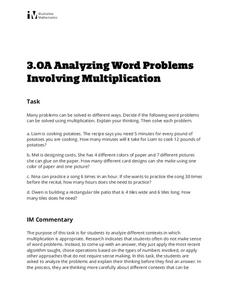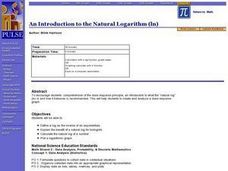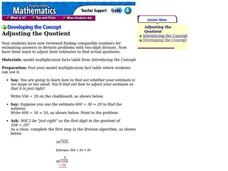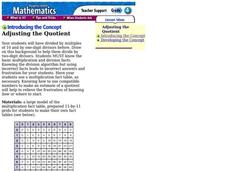Alabama Learning Exchange
Find a Pattern Using Children's Literature
Sixth graders listen to Demi's, On Grain of Rice: A Mathematical Folktale. They use the problem solving strategy of finding a pattern to determine the number of rice Rani will receive after 30 days. They create a spreadsheet which...
Curated OER
Subtraction Relay
Students play a team subtraction game, subtracting two-digit numbers and using addition to check their subtraction. They solve subtraction problems at the board while the team solves the same problem in their seats.
Curated OER
Which Pair?
Students practice solving equations adding decimals and integers. Using a worksheet, they identify which pair of numbers goes correctly with the problem. They review their answers and are graded based a rubric given to them.
Curated OER
Add Groups of Ten
In this addition worksheet, learners add groups of tens and their remainders to determine the missing addends in the pairs of 2-digit problems and then find the sums. Students solve nine problems.
Curated OER
Proving that You Have Found the Minimum
Tenth graders pretend to set up an ice cream shop in a make believe town of shapes. In this geometry lesson plan, 10th graders work together to put up an ice cream stand in an ideal location and solve for the minimum given the shapes.
Curated OER
Computer Passwords
Students determine an appropriate numerical representation of a problem situation, including roots and powers. They determine an appropriate number of digits to represent an outcome. Pupils are asked to determine how many years it...
Curated OER
The Ice Cream Stands Problem
Tenth graders pretend to set up an ice cream shop in a make believe town of shapes. In this geometry lesson plan, 10th graders work together to put up an ice cream stand in an ideal location and solve for the minimum given the shapes.
Curated OER
One-digit Division
Young mathematicians read the book, The Doorbell Rang. They examine the necessity of division in everyday life, such as cooking and sharing. They use paper cookies to construct equivalent sets.
Curated OER
Multiplying Exponents vs. Powers of Powers
Use the power of a power property to solve exponential functions. The lesson refers to differentiating between multiplying or adding exponents to find the value, and how to find the product of a power of a power.
Curated OER
Interactive Fractions
Young scholars determine the common denominator of two unlike fractions. They practice adding fractions and finding equivalent fractions of numbers. They compare and contrast different types of equations involving fractions and construct...
Curated OER
Pac Man Subtraction
Third and fourth graders engage in a game using visual symbols, auditory responses and tactile stimuli to further their understanding of subtraction. A worksheet imbedded in this plan explains how to teach the game.
Curated OER
Analyzing Word Problems Involving Multiplication
Learners sometimes have difficulty making sense of a word problem. In a guided learning activity, pupils are asked to think about how to find an answer and explain their thinking, rather than finding the answer. It allows them to...
Curated OER
Computers Can Only Add
Students explore using mathematics to solve problems in base two. After a teacher demonstration of using base two to write numbers. students model similar problems to explore the concept of number systems in different bases. To increase...
Curated OER
How Many Months?
Students investigate the first Peter the Mint Eagle, who lived at the Philadelphia Mint from 1830 to 1836. They determine how many months Peter was there and use pictures, numbers, equations, and/or words to explain how they came up with...
Curated OER
Multiplicative Sequences
Students investigate the concepts related to the practice of multiplication facts. They look for number patterns in order to create an algorithm in order to find the correct sequencing of number patterning. The solutions are then...
Curated OER
An Introduction to the Natural Logarithm (ln)
Students explore the dose response principle, an introduction to what the "natural log" (ln) is and how it behaves. They create and analyze a dose response graph.
Curated OER
Numerical Analysis: Worksheet 12: Comparing Root-Finding Methods
In this root-finding activity, students rank numbers in asymptotic order. They identify and discuss the roots of the original function. This four-page activity contains approximately 10 problems.
Curated OER
Adjusting the Quotient
Learners solve division problems. In this division lesson, students review estimating and how to figure out if their estimate is too large or too small. Learners solve division problems and use their estimating skills to adjust the...
Curated OER
Numerical Analysis: Introduction to Root Finding
In this introduction to root finding instructional activity, students write equations to solve distance problems. They explore the bisection method of Bolzano. This four-page instructional activity contains approximately ten problems.
Curated OER
Numerical Analysis: Rates of Convergence
In this rates of convergence learning exercise, students explore examples of linear, superlinear and quadratic convergence of sequences. They solve six problems involving sequence converges. This two-page learning exercise contains...
Curated OER
Number Theory - Week 12
In this number theory worksheet, students study integers and their properties. They explore the Fibonacci Sequence and approximate irrational numbers. This two-page worksheet contains eight problems.
Curated OER
Adjusting the Quotient
Fourth graders use number facts to estimate quotients. In this division lesson, 4th graders examine long division problems to determine which multiple of ten will help them determine a number that is close to a quotient. They adjust the...
Curated OER
Constructing Perpendiculars
Students construct perpendicular lines. In this geometry lesson, students use a compass and straight edge to do construction. They start from a point to a line.
Curated OER
Fraction of a Number
Pupils explore how to multiply fractions using color tiles. They use the appropriate strategies for the multiplication of fractions. Students use 40 color tiles to practice multiplying fractions. They practice using various fractions to...

























